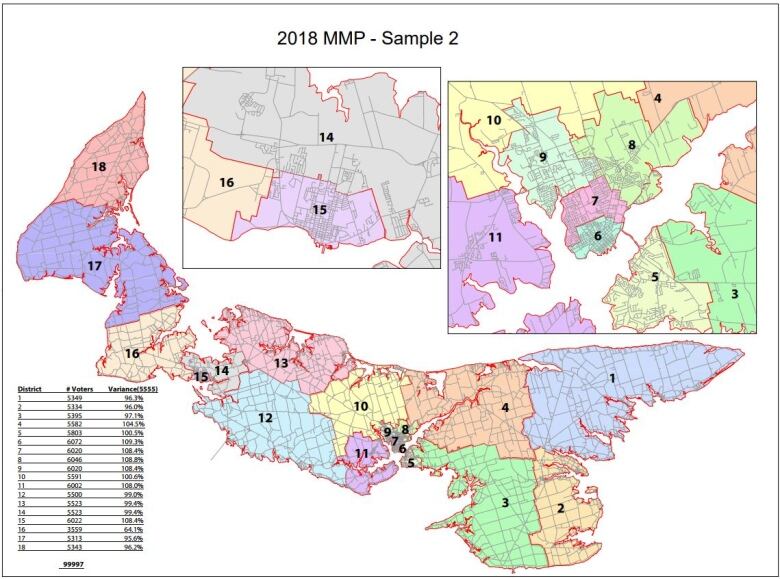P.E.I. boundaries commission unveils 'what if' electoral maps
2 new maps show what P.E.I. could look like under mixed member proportional representation

Two new maps attempt to peer into one possible electoral future for Prince Edward Island.
They show how the province might be divvied up if it becomes the first in Canada to switch to proportional representation.
- Premier calls for work on P.E.I.'s new electoral map to begin
- P.E.I. plebiscite favours mixed member proportional representation
Island voters chose mixed member proportional from among five electoral models including the status quo "first-past-the-post" put forward in a provincial plebiscite in the fall of 2016. That vote has cued up a referendum on electoral reform to be put forward during the next provincial election.
Premier WadeMacLauchlanasked the P.E.I. Electoral Boundaries Commission to develop a map showing what the province would look like underMMP reduced from its current 27 districts down to 18, with the remaining nine MLAsto be selected from party lists.
PC MLA SidneyMacEwenwas at a public meeting in Montague where two proposed maps were unveiled for the first time.
'Large rural districts'
He said the new maps show "really, really large rural districts compared to those in urban P.E.I. You know there's significant concerns right off the bat, as you'd expect when you go from 27 to 18."
Gerard Mitchell, chair of the boundaries commission, said with fewer districts, the average number of voters per district increases from the current 3,700 to 5,500. One of the two proposed maps allows more deviation in terms of the number of voters in each district.
P.E.I. legislation allows for up to a 25 per cent difference, though Mitchell notes the Supreme Court of Canada requires there be a good reason for allowing such disparity, in order to ensure effective representation for all voters.
'What we should try to include or exclude'
Mitchell said the larger size made it more challenging to keep so-called "communities of interest" within the same electoral districts.
"There were issues around where the boundaries should be, what we should try to include or exclude, make sure that we keep municipalities in the same district, try to get school districts within the same district if possible," Mitchell said.
"The larger the district gets, the more difficult it becomes to take all those local concerns into account."


MacEwensaid some of the questions raised at the meetingweren't about the map, but rather about mixed member proportional, and how the system works.
He said those questions went unanswered.
"I expect those type of questions to keep happening, and they'll get that same answer: that this is only about the districts," he said.
Questions remain about proposed system
MacEwensuggested someone be on hand to answer questions aboutMMP. But a spokesperson for Elections PEI said the agencyhasn't yet been asked to run an education campaign on the proposed electoral system.
In his letter to the boundaries commission requesting the map last December,MacLauchlansaid the map would "ensure a level of public education essential on a matter of such fundamental importance as our democratic process," and asked that the work be done before the spring sitting of the legislature.
The next chance for the public to get involved with the commission's sample maps will be Feb. 8. The commission expect to wrap up their public meetings thisFebruary.
- MORE P.E.I. NEWS |P.E.I. woman knits dolls for soldiers to hand out in war zones
- MORE P.E.I. NEWS |Liberals move to protect more fish by overhauling Harper-era reforms












_(720p).jpg)


 OFFICIAL HD MUSIC VIDEO.jpg)
.jpg)



























































































